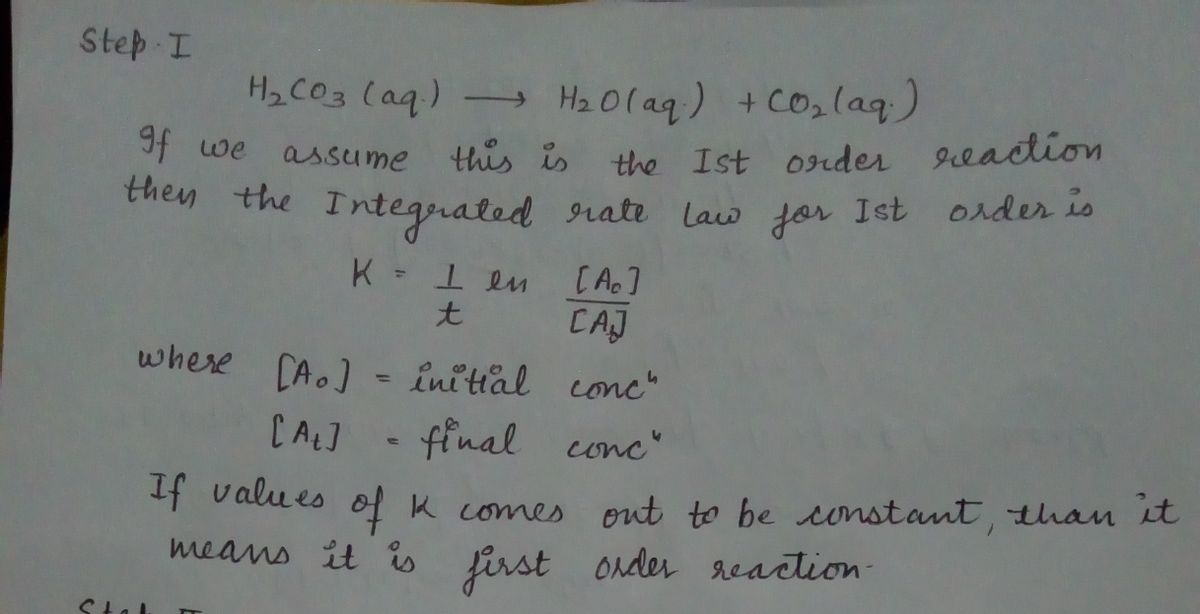A chemistry graduate student is studying the rate of this reaction: H₂CO3 (aq)→ H₂O (aq) + CO₂ (aq) She fills a reaction vessel with H₂CO3 and measures its concentration as the reaction proceeds: time (seconds) 0 1.0 2.0 3.0 4.0 [H,CO,] 0.800M 0.144M 0.0794M 0.0547 M 0.0418M Use this data to answer the following questions. Write the rate law for this reaction. Calculate the value of the rate constant k. Round your answer to 2 significant digits. Also be sure your answer has the correct unit symbol. rate = k k = 0 x10 ロ・ロ X 2 4
A chemistry graduate student is studying the rate of this reaction: H₂CO3 (aq)→ H₂O (aq) + CO₂ (aq) She fills a reaction vessel with H₂CO3 and measures its concentration as the reaction proceeds: time (seconds) 0 1.0 2.0 3.0 4.0 [H,CO,] 0.800M 0.144M 0.0794M 0.0547 M 0.0418M Use this data to answer the following questions. Write the rate law for this reaction. Calculate the value of the rate constant k. Round your answer to 2 significant digits. Also be sure your answer has the correct unit symbol. rate = k k = 0 x10 ロ・ロ X 2 4
Chemistry
10th Edition
ISBN:9781305957404
Author:Steven S. Zumdahl, Susan A. Zumdahl, Donald J. DeCoste
Publisher:Steven S. Zumdahl, Susan A. Zumdahl, Donald J. DeCoste
Chapter1: Chemical Foundations
Section: Chapter Questions
Problem 1RQ: Define and explain the differences between the following terms. a. law and theory b. theory and...
Related questions
Question
![**Title: Understanding Reaction Rates – A Case Study**
**Overview:**
A chemistry graduate student is studying the rate of the reaction:
\[ \text{H}_2\text{CO}_3 \,(\text{aq}) \rightarrow \text{H}_2\text{O} \,(\text{aq}) + \text{CO}_2 \,(\text{aq}) \]
She fills a reaction vessel with \(\text{H}_2\text{CO}_3\) and measures its concentration as the reaction proceeds.
**Data Table:**
| Time (seconds) | \([\text{H}_2\text{CO}_3]\) |
|----------------|----------------------|
| 0 | 0.800 M |
| 1.0 | 0.144 M |
| 2.0 | 0.0794 M |
| 3.0 | 0.0547 M |
| 4.0 | 0.0418 M |
**Instructions:**
Use this data to answer the following questions.
1. **Write the rate law for this reaction:**
\[
\text{rate} = k [\text{H}_2\text{CO}_3]
\]
2. **Calculate the value of the rate constant \(k\):**
Round your answer to 2 significant digits. Also, ensure your answer has the correct unit symbol.
\[
k = \, [\text{Enter your answer here}]
\]
**Graph Explanation:**
The graph provided illustrates changes in \([\text{H}_2\text{CO}_3]\) over time, with concentration on the y-axis and time on the x-axis. The data points plot the measured concentrations at each time interval. Analysis of these points helps determine the rate of reaction and calculate the rate constant.
**Note:**
Ensure calculations reflect changes in concentration over time to properly derive \(k\).](/v2/_next/image?url=https%3A%2F%2Fcontent.bartleby.com%2Fqna-images%2Fquestion%2Fa60cc6ce-11de-444a-af29-e9eb1b50e640%2F810a9451-df4a-4d93-a7d6-14f59114d7fa%2Fhyjulsc_processed.png&w=3840&q=75)
Transcribed Image Text:**Title: Understanding Reaction Rates – A Case Study**
**Overview:**
A chemistry graduate student is studying the rate of the reaction:
\[ \text{H}_2\text{CO}_3 \,(\text{aq}) \rightarrow \text{H}_2\text{O} \,(\text{aq}) + \text{CO}_2 \,(\text{aq}) \]
She fills a reaction vessel with \(\text{H}_2\text{CO}_3\) and measures its concentration as the reaction proceeds.
**Data Table:**
| Time (seconds) | \([\text{H}_2\text{CO}_3]\) |
|----------------|----------------------|
| 0 | 0.800 M |
| 1.0 | 0.144 M |
| 2.0 | 0.0794 M |
| 3.0 | 0.0547 M |
| 4.0 | 0.0418 M |
**Instructions:**
Use this data to answer the following questions.
1. **Write the rate law for this reaction:**
\[
\text{rate} = k [\text{H}_2\text{CO}_3]
\]
2. **Calculate the value of the rate constant \(k\):**
Round your answer to 2 significant digits. Also, ensure your answer has the correct unit symbol.
\[
k = \, [\text{Enter your answer here}]
\]
**Graph Explanation:**
The graph provided illustrates changes in \([\text{H}_2\text{CO}_3]\) over time, with concentration on the y-axis and time on the x-axis. The data points plot the measured concentrations at each time interval. Analysis of these points helps determine the rate of reaction and calculate the rate constant.
**Note:**
Ensure calculations reflect changes in concentration over time to properly derive \(k\).
Expert Solution
Step 1: General information

Step by step
Solved in 4 steps with 3 images

Knowledge Booster
Learn more about
Need a deep-dive on the concept behind this application? Look no further. Learn more about this topic, chemistry and related others by exploring similar questions and additional content below.Recommended textbooks for you

Chemistry
Chemistry
ISBN:
9781305957404
Author:
Steven S. Zumdahl, Susan A. Zumdahl, Donald J. DeCoste
Publisher:
Cengage Learning

Chemistry
Chemistry
ISBN:
9781259911156
Author:
Raymond Chang Dr., Jason Overby Professor
Publisher:
McGraw-Hill Education

Principles of Instrumental Analysis
Chemistry
ISBN:
9781305577213
Author:
Douglas A. Skoog, F. James Holler, Stanley R. Crouch
Publisher:
Cengage Learning

Chemistry
Chemistry
ISBN:
9781305957404
Author:
Steven S. Zumdahl, Susan A. Zumdahl, Donald J. DeCoste
Publisher:
Cengage Learning

Chemistry
Chemistry
ISBN:
9781259911156
Author:
Raymond Chang Dr., Jason Overby Professor
Publisher:
McGraw-Hill Education

Principles of Instrumental Analysis
Chemistry
ISBN:
9781305577213
Author:
Douglas A. Skoog, F. James Holler, Stanley R. Crouch
Publisher:
Cengage Learning

Organic Chemistry
Chemistry
ISBN:
9780078021558
Author:
Janice Gorzynski Smith Dr.
Publisher:
McGraw-Hill Education

Chemistry: Principles and Reactions
Chemistry
ISBN:
9781305079373
Author:
William L. Masterton, Cecile N. Hurley
Publisher:
Cengage Learning

Elementary Principles of Chemical Processes, Bind…
Chemistry
ISBN:
9781118431221
Author:
Richard M. Felder, Ronald W. Rousseau, Lisa G. Bullard
Publisher:
WILEY